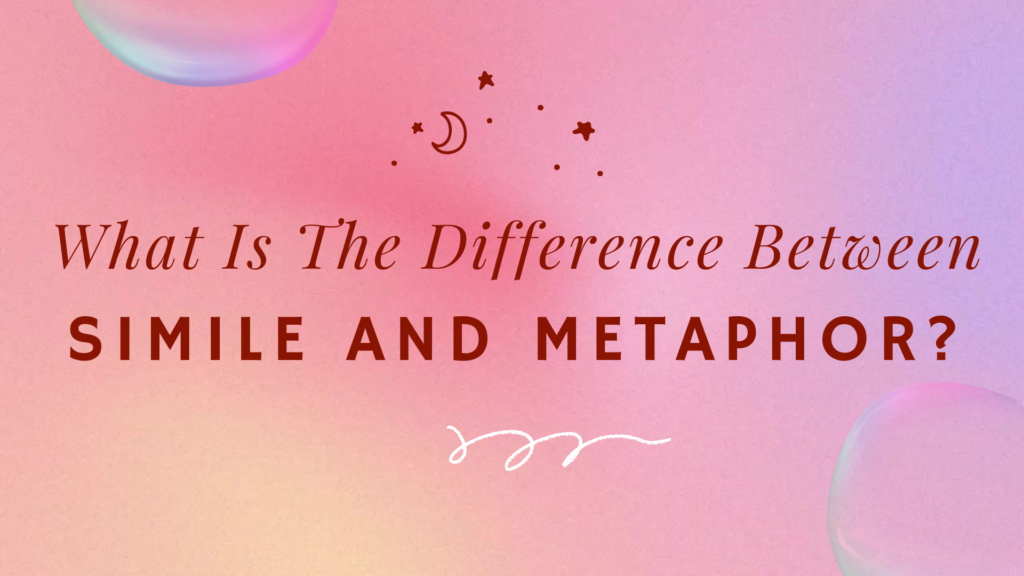
As we all know, language is a powerful tool that can be used to convey complex ideas and emotions. One of the most effective ways to do this is through figurative language, which can help paint vivid pictures in the reader’s or listener’s minds. Two common types of figurative language are similes and metaphors. While they may seem similar at first glance, there are important differences between the two that are worth exploring.
In this article, we will take a closer look at what similes and metaphors are, how they differ, and why they are both important tools for writers and speakers alike.
What is a simile?
A simile is a figure of speech that compares two people, places, or things using the word “like” or “as” when comparing them. Much like metaphors, writers use them in many forms of creative writing to enhance the telling of the story for their audience. An example of a simile is, “The stars gleamed like diamonds.” It is similar to the metaphor example but becomes a simile because the sentence uses the word “like” when comparing stars to diamonds.
How are similes structured?
Similes are structured to compare two things using “like” or “as.” This comparison helps readers or listeners better understand and visualize the described subject. A simile typically consists of two parts: the first part is the subject being compared, and the second part is the object being compared. For example, “He was as sly as a fox.” In this simile, “he” is the subject being compared, and “a fox” is the object being compared to. The words “as” and “sly” connect the two parts of the simile, and the comparison helps the audience understand the subject’s slyness. Similes can be used in various forms of writing, such as poetry, novels, and even in everyday conversations. They are a powerful tool for writers and speakers to create vivid and memorable images in the minds of their audiences.
Here are some examples of Similes from English literature.
1. “I wandered lonely as a cloud” – William Wordsworth, “I Wandered Lonely as a Cloud”
2. “She walks in beauty, like the night” – Lord Byron, “She Walks in Beauty”
3. “The sun also rises, like a great balloon in the sky” – Ernest Hemingway, The Sun Also Rises
4. “The water is as smooth as glass” – Jane Austen, Persuasion
5. “The sky was as blue as the ocean” – F. Scott Fitzgerald, The Great Gatsby.
What is a metaphor?
A metaphor is a direct comparison between two things. Metaphors don’t suggest one thing is like another; they declare that one thing is another: Lis a journey. She has a green thumb. Her eyes were pools of deep blue water. Time is money.
Metaphors are abundant in our language, and often, you will not even know you are using them. Metaphors can enhance descriptions and produce a more impactful effect compared to similes. The figurative language used in metaphors can create a vivid image in the reader’s mind, allowing them to experience a deeper emotional connection to the subject matter.
How are metaphors structured?
Metaphors are figures of speech that directly compare two things without using “like” or “as.” They create a stronger and more impactful effect on the reader or listener than similes, allowing them to feel a deeper emotional connection to the subject matter. A metaphor has two parts: the subject being compared and the object being compared. For example, “Her eyes were pools of deep blue water.” In this metaphor, “her eyes” are the subject being compared, and “pools of deep blue water” are the object being compared. The comparison is direct and declares that her eyes are like pools of water. Metaphors can be used in various forms of writing, such as poetry, novels, and everyday conversations. They are a powerful tool for writers and speakers to create vivid and memorable images in the minds of their audiences.
Here are some examples of Metaphors from English literature.
1. “All the world’s a stage, and all the men and women merely players” – William Shakespeare, As You Like It
2. “Life is a journey, not a destination” – Ralph Waldo Emerson, Self-Reliance
3. “Her heart is a fortress, and the walls are high and strong” – Anthony T. Hincks, The Complete Book of Inspirational Quotes
4. “The moon was a ghostly galleon tossed upon cloudy seas” – Alfred Noyes, The Highwayman
5. “Hope is the thing with feathers that perches in the soul” – Emily Dickinson, Poem 254.
When Do Similes and Metaphors become cliches?
Similes and metaphors become cliches when used repeatedly to the point that they lose their originality and impact. When a comparison becomes too familiar, it no longer creates a vivid or memorable image in the reader’s mind and may even distract from the overall message. For example, “quiet as a mouse” or “busy as a bee” are similes used so frequently that they have become cliches. As an editor or writer, it is essential to avoid using cliches and instead strive for original and imaginative comparisons to enhance the reader’s experience and engagement with the text.
Conclusion
While similes and metaphors are both figures of speech used to draw comparisons, the key difference is that similes use “like” or “as,” while metaphors directly compare two things.
You must know their differences as an editor, especially when working with fiction or creative writing. Furthermore, if you notice your client misusing similes or metaphors – or overusing them, especially ones considered cliché – flag the issue for their review.